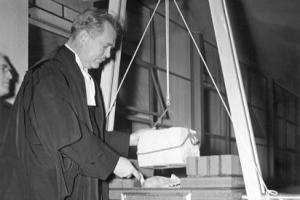
During the Second World War, the Inns of Court in London, England were heavily damaged due to bombings by German forces. In solidarity with the British legal community, the Law Society of British Columbia provided assistance in rebuildings of the Inns of Court. In recognition of this assistance, a stone from the ruined Inner Temple was presented to the Law Society in 1948, and later found a home at the law school at the University of British Columbia where it was installed in 1951.
The Inns of Court in England taught English Common Law, and called qualified practitioners to the bar as barristers with a monopoly to plead in the central law courts. In order to practice, it was required that a barrister belong to an Inn of Court. Inns were also responsible for the eudcation of new barristers, and for the origin of the term 'Bencher,' which was an elected eminent member of the profession recognized as a Master of the Bench. In addition to the Honourable Society of the Inner Temple, three other Inns of Court are still operating in England, including The Honourable Society of the Middle Temple, The Honourable Society of Lincoln's Inn, and The Honourable Society of Grey's Inn.
The Honourable Society of the Inner Temple, from where the stone at Allard Hall originates, developed when the Military Order of the Knights Templar was abolished and lawyers came to occupy the Temple Church which had been their location near the river Thames. The society is first mentioned by name along with the Society of the Middle Temple in manuscripts dating from 1388. The society grew during the middle ages and came to include lodgings, dining facilities, and a library for legal practitioners.
The stone from the Inner Temple was installed at the Second Law Building in a ceremony at UBC in 1951. It has remained at the school since then and is currently located adjacent to the south lawn of Allard Hall.